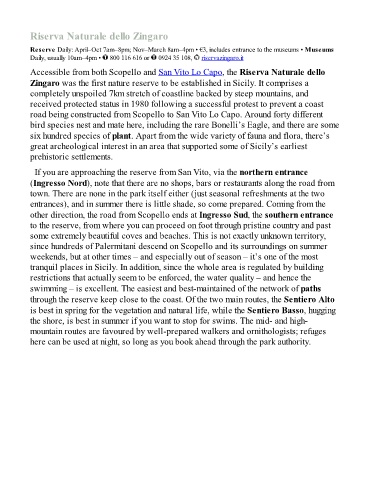Page 485 - The Rough Guide of Sicily
P. 485
Riserva Naturale dello Zingaro
Reserve Daily: April–Oct 7am–8pm; Nov–March 8am–4pm • €3, includes entrance to the museums • Museums
Daily, usually 10am–4pm • 800 116 616 or 0924 35 108, riservazingaro.it
Accessible from both Scopello and San Vito Lo Capo, the Riserva Naturale dello
Zingaro was the first nature reserve to be established in Sicily. It comprises a
completely unspoiled 7km stretch of coastline backed by steep mountains, and
received protected status in 1980 following a successful protest to prevent a coast
road being constructed from Scopello to San Vito Lo Capo. Around forty different
bird species nest and mate here, including the rare Bonelli’s Eagle, and there are some
six hundred species of plant. Apart from the wide variety of fauna and flora, there’s
great archeological interest in an area that supported some of Sicily’s earliest
prehistoric settlements.
If you are approaching the reserve from San Vito, via the northern entrance
(Ingresso Nord), note that there are no shops, bars or restaurants along the road from
town. There are none in the park itself either (just seasonal refreshments at the two
entrances), and in summer there is little shade, so come prepared. Coming from the
other direction, the road from Scopello ends at Ingresso Sud, the southern entrance
to the reserve, from where you can proceed on foot through pristine country and past
some extremely beautiful coves and beaches. This is not exactly unknown territory,
since hundreds of Palermitani descend on Scopello and its surroundings on summer
weekends, but at other times – and especially out of season – it’s one of the most
tranquil places in Sicily. In addition, since the whole area is regulated by building
restrictions that actually seem to be enforced, the water quality – and hence the
swimming – is excellent. The easiest and best-maintained of the network of paths
through the reserve keep close to the coast. Of the two main routes, the Sentiero Alto
is best in spring for the vegetation and natural life, while the Sentiero Basso, hugging
the shore, is best in summer if you want to stop for swims. The mid- and high-
mountain routes are favoured by well-prepared walkers and ornithologists; refuges
here can be used at night, so long as you book ahead through the park authority.

